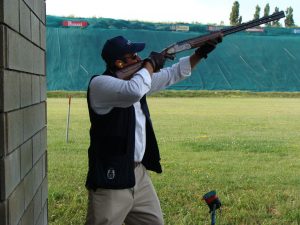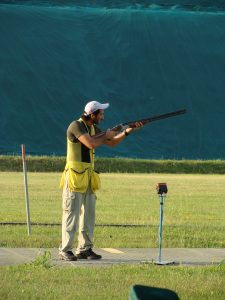Skeet Shooting
In the 1920s, Charles Davis of Andover, Massachusetts, wanted to improve his shotgun skills. An avid grouse hunter, Davis recognized that the shot presentation in traditional competitive trap events (a game where the target is always angling away from the shooter), didn’t accurately mimic hunting conditions in the field. Davis knew he needed to practice shots from a variety of different angles, so he developed a shotgun sport he called the “Clock Game.”
In this event, there were 12 stations situated in a circle around a single trap house that threw targets through the center of the circle. Each shooter would, in turn, stand at all 12 positions around the clock face, shooting two targets at each station. The last of the 25 shots was taken from the center of the ring, with the target flying directly over the shooter’s head.
Davis found that this type of shooting greatly improved his shooting skills. What is did not improve, however, was his relationship with his neighbors, who complained that shot was raining down on their farm each time Davis played his new shotgun game. To remedy this and keep the peace, Davis cut the shooting circle in half and placed a trap at either end of the semicircle’s diameter points. This layout became known as “skeet,” a name borrowed from the Scandinavian word skyte, which means to shoot.
Today, skeet is one of the most popular of all shotgun events. The National Skeet Shooting Association has thousands of members and hundreds of clubs in every state.
The skeet format has long been formalized. Station No. 1, on the left top end of the semicircle (the bottom of the scoop is the back of the skeet field) is directly under the “high house”; it is the 9 o’clock position if you were looking at the field from overhead. The trap machine that throws the clay target is above the waiting shooter, thus the term “high house.” It is usually housed in a wood tower with a flight of stairs inside that lead to a platform where the target thrower sits.

The author shooting on station No. 1. The “high house” trap is behind and above him, housed in the cinderblock tower.
After shooting the first station, shooters travel around the semicircle in a counterclockwise fashion to station No. 2 (8 o’clock), No. 3 (7 o’clock), No. 4 (6 o’clock), No. 5, (5 o’clock), No. 6 (4 o’clock) and finally directly next to the port for the trap to the “low house,” which is station No. 7. The final station, No. 8, is located directly between the two houses on the diameter line of the semicircle (what would be the dial point for the hands of a clock). Here, targets from both the low and high house pass almost directly overhead the shooter. Shooting all eight stations is considered a round of skeet.
Skeet is a game of 25 rounds, which corresponds directly to the number of rounds in a box of target shotshell loads. Here’s how the progression of targets is shot:
- Station Nos. 1 and 2—One high house clay bird thrown singularly, one low house clay bird thrown singularly, a pair of both the low and high house birds thrown simultaneously, something called a “true pair.” (Four shots total at each station for a total of eight.)
- Station Nos. 3, 4 and 5—One high house clay bird thrown singularly, one low house clay bird thrown singularly. (Two shots at each station for a total of six.)
- Station Nos. 6 and 7—One high house clay bird thrown singularly, one low house clay bird thrown singularly, a pair of both the low and high house birds thrown simultaneously (more true pairs). (Four shots total at each station for a total of eight.)
- Station No. 8—One high house clay bird thrown singularly, one low house clay bird thrown singularly (Two shots total. Total shots utilized = 24).
Remember I said that skeet is a game of 25 shots? As you can see from the totals above, if you shot a perfect game all the way through both shots at station No. 8, you’d have a round left over in your box of 25. In informal competition and many league shoots, that last round used to be called the “shooter’s option,” meaning the shooter could take it where they preferred at the end of a clean round or on a station where they missed a target. In formal competition today, for clean rounds (no misses through the 24th shot), the final shot must be taken at low house No. 8 (considered to be the toughest target in the game by many.)

A competitive shooter stands at station No. 8 in the center of the skeet field’s semicircle diameter line. The speaker in front of him is actually a voice-activated target launcher. The shooter calls “Pull,” and the speaker activates the launcher.
Though the way the targets fly from the two skeet houses is the same every time, to the shooters, the shot angle changes as they move around the semicircle. This means that the shooters will have to adjust to these different target angle “presentations,” as well as a variety of distances as they move backwards and away from the clay throwing houses until station No. 4, then nearer to the houses but at the opposite side of the field by the time they reach station No. 7, making skeet a very dynamic and challenging shotgun sport. There’s an international form of the game known as “Olympic skeet,” where the targets are thrown at higher speeds and shooters are required to start from a “low gun” (shotgun off the shoulder) position.
Tough as it can be, skeet teaches many of the fundamentals of good shotgun shooting and, for upland game bird and waterfowl hunters, there is perhaps no way to better prepare yourself for all the different shots you’ll encounter in the field. Particularly helpful to hunters is that one of the key elements in skeet shooting (indeed all shotgun shooting that involves a moving target), is to keep the gun moving, even after the shot. Skeet also teaches shooters to remain “target focused,” meaning the shooter will keep both eyes fixed on the target instead of the sights of the gun. This is a completely different way of shooting and a radical departure of the skills used in handgun and rifle shooting.
Perhaps the best thing about skeet is that it doesn’t require any special equipment or firearms. You can use most any repeating shotgun for skeet, including pumps, side-by-sides, semi-autos and over/unders and any chambering from .410-bore up to 12-gauge. Most shooters will use a shooting vest of some kind, especially serious competitors, who will have the vest padded in the shoulder area where they mount the shotgun. But other than that and eye and ear protection, there’s no great need for lots of specialty equipment or accessories, making this an easy sport for new shooters to try.
Ready to give skeet a whirl? Check out NSSF’s wheretoshoot.org.